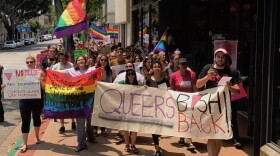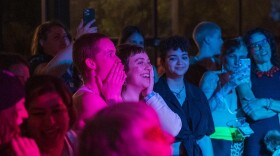The local drag scene is one of the most inclusive and affirming spaces for LGBTQ+ people of color in San Luis Obispo County.What was once an underground subculture has now gone mainstream — not just here, but across the nation. It's led to a backlash as some states pass laws banning these queer-centric events, and there’s even some anti-drag sentiment here in SLO County, as well.
Drag is a form of entertainment where performers dress up and challenge stereotypical gender norms through performance art. As the famous drag queen RuPaul likes to say, “We’re all born naked and the rest is drag.” Rupaul once described drag as an act of rebellion, a way to comment on society, “and a big f-you to male-dominated culture.”
Vincent Torres is a resident advisor at Cal Poly San Luis Obispo and a drag performer who goes by the stage name Skinny Mocha. They say drag can be a way to turn society’s idea of gender into art that you can share with an audience.
Torres said it doesn’t need to follow a formula or a stereotype — you can even be a cisgender woman dressing up like a more feminized version of yourself.
"You can be kind of this person with your own idea of gender, presenting the idea of gender to the audience. So you don't have to dress up like a man or dress up like a woman, you can be this kind of alien being," Torres said. "And I think that's what the beauty of drag is, it doesn't have boundaries. And I think that's also what scares people."
Drag culture is a major part of queer nightlife. Its roots can be traced back to Shakespeare, and it was a prominent attraction at the underground ballrooms that began in 1920s Harlem.
Drag made its way into the mainstream with performers like RuPaul appearing on popular 90’s TV shows, like “Geraldo.” But it wasn’t until “RuPaul’s Drag Race” premiered as a regular TV series in 2009 that the world began to see drag in a different light.
It’s now gone from an underground art form to one that most people in the country know about. Torres said there are now vibrant drag communities all over the country, including here in San Luis Obispo County.
"Drag is something that is increasingly becoming more mainstream and more part of popular culture. [It's] more both influential of and influenced by popular culture," Torres said.
But when Torres moved away from their hometown to attend Cal Poly, the local drag scene wasn’t as rich and thriving as it is now. As a queer, gender-fluid, person of color, Torres struggled their first year here to find community in the very white city of SLO. But once they were free to explore and be themselves in college, they soon discovered the drag club on campus and experienced a “personal renaissance.”
"Drag is gender performance, but more so for me it's gender catharsis, in a way. [I] carry it with me into my everyday life, and kind of use it as wind beneath me to kind of propel me forward in whatever I need," Torres said.
San Luis Obispo County doesn’t have any gay bars or other late-night establishments that are LGBTQ+ specific, so drag shows are finding their way into other places known for their queer inclusivity — like Libertine Brewing Company and Bang the Drum Brewery in SLO.
Gray Gautereaux, a board member for the Gala Pride and Diversity Center, said there’s no right way to do drag.
"It's not that much different than Disneyland. But you don't have to break your bank to do it, and you can also be as gay as you want."Gray Gautereaux
"People are at drag shows because they want to be there and because they have fun there," Gautereaux said. "I mean, who doesn't want to drink a couple mimosas and get to dance around with some people in costumes? It's not that much different than Disneyland. But you don't have to break your bank to do it, and you can also be as gay as you want."
Despite the joy expressed through drag, it’s a controversial topic across the nation, especially as anti-drag legislation and hate incidents are on the rise. After last November’s mass shooting at a drag performance in Colorado Springs, the San Luis Obispo restaurant Highwater SLO started receiving hateful comments and messages about the drag brunch events they put on.
They posted on Instagram that another local business owner had accused them of “exposing children to inherently sexual events,” and claimed it’s “their life’s work” to stop venues from hosting family-friendly drag events. The same messages were allegedly sent to several other businesses in SLO.
Gautereaux said the LGBTQ+ community and their allies know there is nothing bad or harmful that goes on at drag shows and other queer-centric gatherings, especially family drag events. They said they’re places of love, joy, art and partying for all ages.
"But I do acknowledge that that comes from a place of privilege. And when I see artists like Skinny Mocha — you know, we've got some really awesome, POC queer drag artists — I know that it must take even more bravery because there is, you know, threats of violence, and there is threats against our identity," Gauteraux said.
Gauteraux said these events create spaces free of prejudice for the performers while also allowing the audience to experience the joy of drag, whether they identify as queer or not.
"We still have a place in our community where these artists are coming out and giving the most and just being so wonderful. That is what keeps me like encouraged that we're doing something right and that we have a good space here for our people to thrive," Gauteraux said.
Juicy CW has lived in SLO County their whole life and goes by any pronoun under the rainbow, but said you can address them as “your majesty” since they won Miss Central Coast Pride in 2018.
Juicy is half-Mexican and grew up in a very religious family. Their grandpa was a pastor. Juicy said they were terrified of drag queens as a kid.
But then, they attended their first drag show at SLO Pride in the late 2000s and fell in love with the art form. They started watching “RuPaul’s “Drag Race” and immersing themselves more in the local queer community. Juicy began to dress more femme, and then one night they entered a lip-synch contest.
"After that, I was like, ‘Wow, I love drag. I want to try it.’ And so I kept practicing my makeup, tried to do more traditional drag makeup, tried to do more drag wigs, outfits and experimenting," Juicy said.

"And then I would go to the SLOQueerdo drag shows dressed up, and they saw me, they saw the effort, they saw my passion for it. And at Pride I went up to one of the people [with] SLOQueerdos and I was like, 'Hey, you know, I love drag, I really want to perform and be a part of it.'"
Shortly after, Juicy won Miss Central Coast Pride. It was a very different experience than when they used to be harassed and bullied in SLO before they began doing drag. They recall times they had to dodge cameras or reconcile with being sent flowers from men at bars as a cruel joke.
Juicy said they “always felt like a failure.” They struggled in school, and were eventually expelled from high school and then continuation school. For them and many other queer and trans people of color, drag is more than just art: it’s a way of healing emotional wounds.
"I've always felt unaccomplished," Juicy said. "I've always felt like I couldn't amount to anything, and nothing I ever did was good enough, until I found drag."
Queer spaces have been subject to threats for as long as they’ve existed. As the popularity of drag grows, so will the community's resilience to continue thriving, as ballroom and drag have in the past. These brave spaces offer safety, not only to the LGBTQ+ community, but to allies and friends.
Juicy said the need for these sanctuaries is crucial, especially for queer youth who may not have another outlet to explore their creativity and identity.
" When people look down on you, and people don't expect anything from you, it's really, really hard on your emotions and your mental state — and because all people want to do are live and exist and make people, see them and make people proud," Juicy said. "When I go out into shows or when I go out into clubs, or go to events in drag, and people are so happy to see me there — that is so healing."
Throughout this series In Between, we’ve talked to community members, organizations and queer and trans people of color living life on the Central Coast. While living queer and POC in San Luis Obispo County presents many challenges, this community is very much here, and they are resilient. They’re speaking out, finding and providing resources for one another, and filling the needs they see for themselves and others — like Reese Galido with “Let There Be Lesbians” and Faith LeGrande with “Art and Soul.”
Pride Month is around the corner, and SLO County's LGBTQ+ community is gearing up for the month-long celebration. There’s a lot more to be done to reach true equality for LGBTQ+ people of color, but change is happening by the community for the community. As RuPaul says, “If you can’t love yourself, how in the hell are you gonna love somebody else?”
In Between is made possible by a grant from the Community Foundation San Luis Obispo County.








